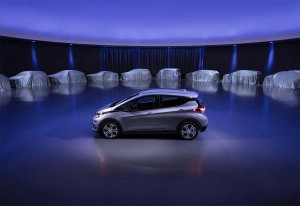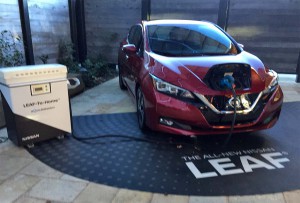
The Chevrolet Bolt is now one of the world's best-selling plug-based vehicles, and GM has more coming.
Motorists around the world are showing signs they’re getting charged up by a new wave of plug-based vehicles, global sales passing 1 million for the first time ever in 2017, and U.S. demand setting a new record during the final month of the year.
Though still making up only a small fraction of worldwide motor vehicles sold last year, demand for plug-in hybrid and pure battery-electric vehicles, or PHEVs and BEVs, has been rising rapidly, according to a new report from Navigant Research. A variety of reasons get credit, including declining prices and the availability of more products, especially longer-range models like the Chevrolet Bolt EV, Tesla Model 3 and second-generation Nissan Leaf. Rising oil prices are also playing a factor.
“Battery costs have shrunk dramatically in the last five years and promise to shrink further with the commercialization of solid-state batteries on the horizon,” says Scott Shepard, a senior research analyst with Navigant. “In addition, increasing regulatory pressure in Europe and China may well push the PEV (or plug-based vehicle) market to the aggressive end of the forecast range regardless of oil prices.”
The oil price slump earlier in the decade threatened to unplug demand for battery-based vehicles, sales falling short of what many optimists had hoped for. That was especially apparent in the decline of more conventional hybrids, such as the Toyota Prius.
(Tesla misses by a mile its Model 3 target. Click Here for the story.)
But the shift to electrified vehicles has been regaining momentum, especially in the plug-based segments. According to data published by EVvolumes.com, combined sales of PHEVs and BEVs jumped from 325,000 in 2014 to 546,000 in 2015, a 68% increase. The numbers rose another 42%, to 774,000 in 2016. While final figures have yet to be confirmed, the Navigant study indicates sales were up by at least another third in 2017.
Along with lower costs, longer range and the availability of more models, sales of plug-based vehicles are being encouraged by new regulatory efforts. These include hefty incentives, as well as new rules demanding manufacturers boost sales of these green vehicles. China, for one, recently enacted strict new sales targets and regulators are studying the possibility of a complete ban on vehicles using internal combustion engines.
In Norway, where such a ban is slated to take effect in about a decade, conventional hybrid and plug-based models accounted for more than half of all new vehicle sales in 2017. India also plans to phase out gas and diesel vehicles, and the U.K., France and Germany, as well as a number of European cities, are considering similar bans.
In the U.S., motorists bought 199,826 plug-based vehicles last year, up 26% from 2016. And December saw the largest number of PHEVs and BEVs purchased by Americans since the first of these vehicles went into mass production seven years ago, according to industry data.
(Click Here for more about China’s newest EV coming to CES 2018.)
“The sale of electric vehicles (is) shifting into the fast lane,” said Gina Coplon-Newfield, transportation director for the Sierra Club. “More and more people are realizing that these cars are not only cleaner to drive, but they save money at the pump and at the mechanic. We should expect sales to continue to accelerate as more and more cars become available and thousands more charging stations come online.”
On the positive side, the new tax changes approved by the GOP-controlled Congress retained credits of up to $7,500 for buyers of qualifying vehicles. The loss of those incentives, many analysts had predicted, would have led to an immediate slump in sales.
But battery-car proponents worry that the surge could be short-circuited, at least in the U.S., by the Trump Administration which has been considering a rollback of the Corporate Average Fuel Economy standards. The 54.5 mpg target phasing in through 2025 was widely expected to require manufacturers to shift to more and more battery-based powertrains, from mild hybrids up to pure electric.
“While most of the global market can expect robust growth in the near term, the outlook in the United States is less certain based on the potential for federal level policy changes,” noted a statement by Navigant Research. “If US fuel efficiency policies and government subsidies are relaxed or removed, the country will find it difficult to keep pace with other markets.”
It is unclear if and when the Trump Administration might act, but not all battery-car proponents think a rollback of CAFE would end the surge in sales. They note that California, which has the ability to set its own standards now adopted by 11 other states, is expected to actually toughen its rules.
(To see more about the EV tax credit surviving Trump’s tax plan, Click Here.)
And several automakers, including Honda and Nissan, have told TheDetroitBureau.com that they will move ahead with their electrified vehicle plans no matter what the White House rules. Others may take a similar approach. General Motors plans to add two more BEV models by mid-2019, and global product chief Mark Reuss said last autumn that the company will have at least 20 all-electric models in its fleet by 2023.


The OEMs that continue to simply consider PEVs as an alternative fuel vehicle and create products in the least cost fashion just to meet the mandates will likely see the Trump Administration policy actions impact their compliance car PEV sales. The OEMs that fundamentally try to leverage the advantages of electric drive to make compelling vehicles with such attributes as superior performance/NVH/maintenance, packaging/interior space advantages, or home charging convenience will still carry on and probably grow market share with superior products despite policy or gasoline prices.